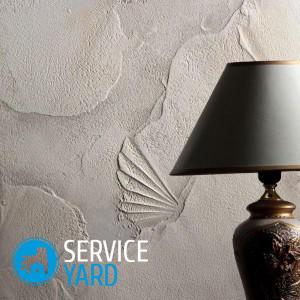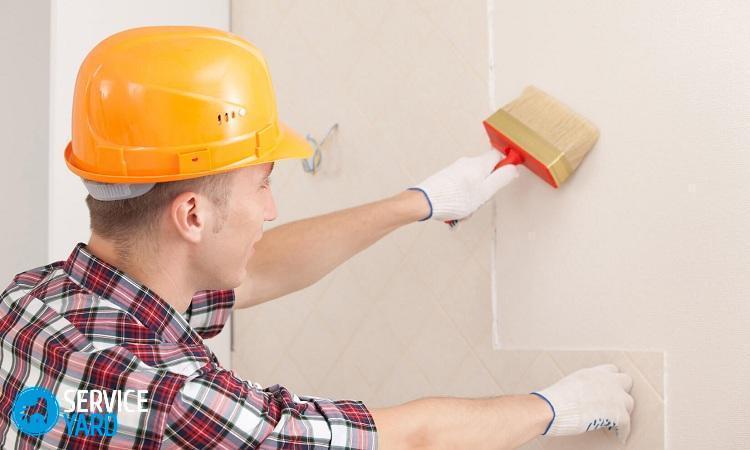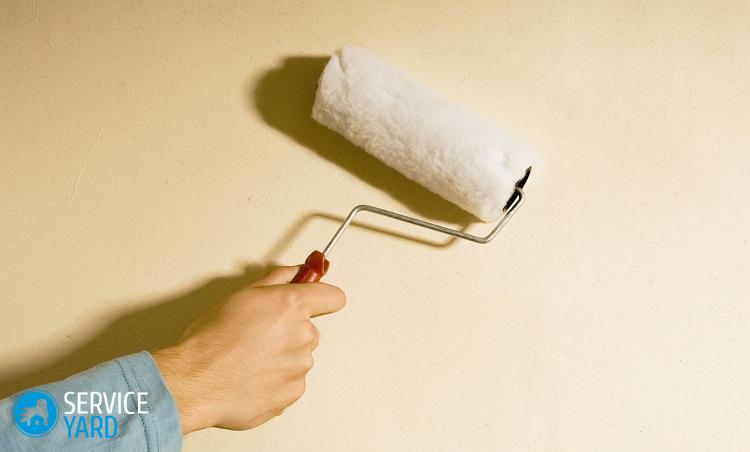What is the best primer for wallpaper walls?

During many repairs, the priming stage is mandatory, and this does not always depend on the material at the base of the structure, but more often on a set of factors. What is the best primer for wallpaper walls? - This question cannot be answered unequivocally, because several important nuances must be taken into account. If in “two” words, then you need to take into account which wallpaper you will be gluing to which surface. In this article, we will examine in detail regarding the correct choice of soil coating of walls.
to contents ↑Why is it worth priming the walls?
And is it really necessary to apply this same primer, because before during repairs it was perfectly possible to do without it. Maybe this is the invention of marketers for pumping money?
We have to disappoint you, you have to fork out on the ground. After all, we live in the XXI century, so we are unlikely to glue paper wallpapers on newspapers. On the building materials market, buyers have long preferred vinyl, non-woven, liquid wallpaper and paint wallpaper. They are much heavier than paper. In addition, the walls of modern houses have long been not limited to concrete and brick. This can be drywall, gas and foam blocks, expanded clay concrete, various types of putties, plasters. And all these materials require their own approach to combine the surface and the type of finish.
Important! What is the best way to prime walls before wallpapering? If you want to make redecoration of cheap materials, then you can not splurge on the primer. For paper wallpaper on a brick or concrete wall, instead of soil, wallpaper glue or PVA glue diluted with water (1: 7) is quite suitable.
But if you want to do everything efficiently and correctly, then cover the walls with a primer necessarily. In this case, priming the walls with glue before wallpapering will be a bad option.
to contents ↑What is a primer for?
The primer is the intermediate link between the finish and the base. This link plays an important role in the quality of the entire repair. So what does the primer do?
- Increases the adhesion of the wall and decoration materials, wallpaper, for example.
- Impregnation of the wall with soil reduces the consumption of wallpaper glue.
- Soil increases the moisture resistance of the wall, while not reducing air circulation.
- Soil additionally levels the surface of the wall, filling pores, cracks, small irregularities.
- Application of a primer is an additional dust removal of a surface after preparatory work.
- In good primers, drugs are usually added to prevent the appearance of fungus, mold, rust.
- Soil does not allow the lower layer of wallpaper to exfoliate.
As you can see, the primer has a lot of advantages. In addition, applying it to the wall is not particularly difficult. You only need to stir it in a bucket and roll the wall with a roller.
PVA glue for wall priming under the wallpaper, like wallpaper glue, can be considered as an economical version of the primer. But they do not perform so many functions - they only slightly improve the adhesion of the wall to the wallpaper, and then, they are not suitable for all types of surfaces.
to contents ↑Important! For a painted, wooden or metal wall, a special primer is needed, here PVA will not help out.
Types of primers
There are two groups of soil:
- adhesive - improving the adhesion of two surfaces;
- strengthening - fastens the surface particles together and fills the pores.
But in appearance, the soils are divided according to the surface on which they are applied:
- Acrylic.
- Alkyd.
- Gliftal.
- Mineral.
- Perchlorovinyl.
In appearance, they can be in the form of a liquid solution, concentrate or dry mixture.
Important! Before making a purchase, measure the area of your walls, as the ground tank is designed for a specific quadrature. Do not forget to take into account the number of layers that will have to be applied - it depends on the features of the surface.
Now we will analyze in more detail each type of soil.
Acrylic (emulsion) primer
Probably the most universal of all, as it is suitable for most types of surfaces: concrete, brick, wood, plywood, even loose plaster.
Important! The only surface not intended for acrylic primers is that containing ferrous metal.
Features of acrylic primer:
- Acrylic primer for interior use is readily soluble in water, has no unpleasant odor and dries quite quickly (from 2 to 5 hours).
- There are several varieties of this soil:
- impregnating - is intended for impregnation of a loose base in depth up to 10 cm;
- Strengthening - does not penetrate deeply, is needed to bond a small fraction on the surface, that is, strengthens the base;
- adhesive - lays on the surface with a dense film and levels the base.
Important! Good primers are products of the companies “Primer”, “Kompozit”, “Founded”, “Knauf”, “Perfect”, “Prospectors”.
Alkyd primer
Designed for wood, even previously painted (indoors) and metal (inside and outside) surfaces.
Important! Durable alkyd primer can also be used for galvanized steel, glass and tile. But for plaster and drywall, it does not fit.
Features of alkyd primer:
- This primer dissolves with organic solvents, so it has a characteristic odor. It dries 10-16 hours.
- They are divided into those containing zinc chromate and those containing zinc phosphate.
- Designed for wooden surfaces - fasten pores of wood, reduce absorption, prevent swelling of fibers, and also protect from rot and mold.
- Soils intended for metal transform rust and prevent its further spread.
Important! Such soils are represented by the brands “Kompozit”, “Aura”, “Tikkurila”.
Gliphthal primer:
- Suitable for wooden (wood and lumber) and metal (ferrous and non-ferrous metals) surfaces, to prepare them for painting.
- Designed for surfaces more or less resistant to moisture.
- The coating is homogeneous, solid, anti-corrosion, with a high degree of adhesion.
Important! The oldest primer from this series is GF-020, now instead of it they take GF-0119, GF-021 (there is a quick-drying look). Such a coating dries for about a day.
Mineral primer
It is made with lime, gypsum or cement. It is used for processing concrete (also expanded clay concrete), brick (including gas-silicate brick), and also plastered surfaces.
Features of the mineral primer:
- After application, it fills the surface pores well.
- It dries in just a couple of hours.
Important! With increased humidity in the room, the drying period may increase.
- Primers from Primer, Remmers, Ceresit, Caparol have good reviews.
Vinyl chloride primer
Designed for brick, concrete, metal surfaces. Suitable for internal and external use. Most often it is used for metal surfaces that are covered with scale and rust.
Features of perchlorovinyl primer:
- It dries quite quickly in the heat, about an hour.
- In its composition, this primer contains toxic substances, so its use in residential premises is undesirable.
to contents ↑Important! Still there are such not often used types of soil:
- Polyvinyl acetate - designed for concrete, brick, drywall and stone before applying polyvinyl acetate paint.
- Phenolic - designed for metal and wood before painting. Toxic
- Polystyrene - for plaster and wood. Toxic
Primer for wallpaper - which is better for preparing the wall for wallpapering?
Let us dwell on which primer to choose for walls for wallpaper:
- Practice shows that acrylic primer is most in demand as the most versatile, easy to apply, non-toxic and odorless. It fits most walls, it is also used before applying liquid wallpaper, although in this case the soil is applied in several layers.
- If you will not wallpaper wallpaper in an apartment, but, for example, in a garage or in a country house where conditions are not quite standard, then study the features of all types of primers and choose the right option.
We ground the walls under the wallpaper
To do everything in order and correctly, you need to prepare the necessary tools in advance and study in detail the process itself.
Necessary equipment for work:
- Bucket to stir the mixture.
- Bath.
- Roller. It is advisable with a telescopic handle so that you do not have to drag a chair or stepladder with you.
Important! The surface of the roller nozzle may be made of foam rubber, velor or pile.
- Brush. It will be needed for corners and inaccessible places.
Primer sequence:
- Before priming, it is necessary to prepare the surface. To do this, clean the walls from sockets, nails and screws, old wallpaper, whitewash and plaster. If the wall was previously painted, then the paint must be removed.
Important! It is more convenient to remove oil paint with a spatula or a special scraper - it will fall off in layers. A water emulsion is more difficult to remove - you have to clean it with sandpaper.
- When the surface is cleaned, stir the soil according to the instructions, pour the portion into the paint tray and begin to apply onto the walls with a roller.
- Pick up the amount of primer on the roller so that it does not run down the wall in streams.
Important! There should be no drips, but also make sure that there are no dry areas. The surface of the wall should be evenly covered with soil. Hard-to-reach spots are smeared with a brush.
- Next, wait for the drying of the first layer.
Important! Each type of primer has its own drying time.
- If necessary, apply the second and subsequent layers.
- Only after the surface is completely dry, proceed to finish it, for example, wallpapering.
Useful tips to help you avoid the most common mistakes:
- Do not apply dispersion and water-based paints instead of the appropriate primer.
- Do not rush to glue the wallpaper, let the soil dry completely.
- Try to always apply two coats of primer, as during the initial treatment you can skip some areas.
- When choosing a primer correctly correlate the type of surface and type of finish.
- When buying soil, carefully read the composition on the label. You can sell ordinary PVA glue under the guise of quality raw materials.
- If you are doing solid repairs “for centuries”, then do not skimp on high-quality building materials, choose a primer from trusted manufacturers.
Stock footage
It is better not to skip the stage of priming the walls during the repair process, because this is a kind of guarantee of the quality of the cosmetic coating. Primer glue before wallpapering is not always suitable, in most cases it will be better to purchase specially designed raw materials and process the walls with them. Choosing it correctly and doing the work will help the recommendations from this article.
- How to choose a vacuum cleaner taking into account the characteristics of the house and coatings?
- What to look for when choosing a water delivery
- How to quickly create comfort at home - tips for housewives
- How to choose the perfect TV - useful tips
- What to look for when choosing blinds
- What should be running shoes?
- What useful things can you buy in a hardware store
- Iphone 11 pro max review
- Than iPhone is better than Android smartphones





